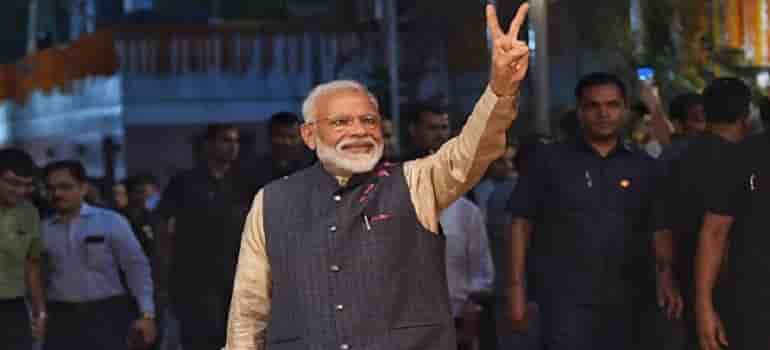
Freshly elected by the sovereign of India, Narendra Modi led BJP government will start its second stint not with a 100-day agenda, but a 1,000-day agenda that will run up to the first half of 2022, the 75th anniversary of India’s independence. People with direct knowledge speaking to CS on condition of anonymity said that the new government’s plan will include several initiatives, from propelling green initiatives like solar and EV to empowering women in agriculture, sending an Indian into space. In his second term PM Modi looks to fulfil his promise of creating a “New India”.
Sectors like renewable energy, battery energy storage, and electric vehicles are expected to largely benefit as this government was the first to push the green program in the country.
Recently Indian government’s leading think-tank Niti Aayog proposed electrifying motorbikes and scooters within the next six to eight years to curb pollution and reduce dependency on fossil fuels. The draft proposal from Niti Aayog, which is chaired by Prime Minister Narendra Modi, plays a critical role in policy making, it also recommends electrifying the country’s popular three-wheeled auto-rickshaws.
PM Modi had led the Bharatiya Janata Party and the NDA to a super-sized victory. The alliance picked up 349 of the Lok Sabha’s 542 seats. The BJP won 302 seats, far beyond the 272 that the party needs for a majority in the Lok Sabha. This is the first time since 1971 that any Prime Minister has been re-elected to office with an outright majority.
As the newly elected PM gears up to take oath on 30th May, we reached out to EV Industry experts to understand what it expects from the new government, here is the excerpt :-
Yogi Rajpal, Head (Technical) e-Mobility, Sterling and Wilson Pvt. Ltd.
- Let the market and manufacturers decide the type of interface required for charging specifically 4 wheelers and Busses.
- For Two/Three wheelers standardize Type 2 connector so that electricity theft can be reduced, even if they use battery swapping that’s ok but charging connector for 2 wheelers needs to be standardized.
- Reduce customs on EV chargers components for coming 2 years then start increasing them.
- Let the market decide the rate for charging do not cap a % .
- Provide incentives to companies ready to invest in public charging infrastructure by way of lower rate on loans , provide carbon credits.
- Enable the chargers to be Grid connected for future V2G(Vehicle to grid) applications.
- Promote (provide incentives) EV chargers with PV (solar) integration along the highways.
- Currently states are fixing the rates which will be charged for connections to EV chargers, this is making some states lucrative and others not,
- provide incentives to states so all other (non-participating) states can also join in for providing such incentives for EV charging infrastructure making the initiative truly national.
- Concentrate on Tier 2 and Tier 3 cities as well for EV 2 wheelers and EV 3 wheelers – growth will start trickling in nationwide.
Divyam Gupta, Director, Snelcharge India Pvt Ltd
- Lower GST on Chargers as 99% it will be capital goods for all owners. Whether station owners or Local retail customers
- VGF for putting up Charging stations
Sameer R Kulkarni, GM – Sourcing, JBM SOLARIS ELECTRIC VEHICLES PVT LTD.
- Quick decision on pending reveling of Tenders for E- Buses.
- Preparation of Charging Infrastructure.
- Sufficient availability of Electricity to feed Charging Infrastructure
- Support to Build Component Manufacturing to meet FAME-II norms.
Sushovan Bej, Consultant, Ernst & Young
The electric mobility story does not need to bank upon the old story of what need to come first. With the theory been established that charging infrastructure needs to come first for the proliferation of the electric mobility, what remains to be seen how the market works to quickly churn out market fit products. The government today should only play a facilitative role to maintain sustainability of the ecosystem and let the market grow itself.
Vaibhav Deshwal, Business Consultant, Semco Group
- Do not create own standards for EV chargers.
- We actually don’t need CCs and ChaDeMo ports working simultaneously in the chargers.
- Technology comes with a cost but it ensures sustainability.
- Make in India is a good initiative for chargers.
- Lower the GST and import duty on chargers and its components.
- Govt. must work on a plan with short deadlines. We can always divide the journey in smaller parts and fix deadlines for them rather than aiming directly for 2023.
- More focus on assembly of Li-ion packs in India, and lower the tax rates on imports of cells and GST on the batteries until the price comes to a viable bracket.
- Smart Grid activities must be promoted and subsidised
- Let the industry decide the pricing strategy for EV charging and there should be no %age cap from the govt’s end
- Push and incentive for private firms who would like to electrify their fleets.
Rushi Shenghani, Founder CEO, Earth Energy EV
There is going to be a phenomenal push from all the EV and traditional Vehicles companies to make and market Affordable electric vehicles as it will be mandatory to switch to 2 Wheeler EVs till 2025 and 3 wheeler EVs till 2023
We expect stricter emissions norms levied on the Traditional Companies to make them shift to Electric and hence push the ecosystem to adopt electric Vehicles.
(This story has been updated with input of Yogi Rajpal, Head (Technical) e-Mobility, Sterling and Wilson Pvt. Ltd )

